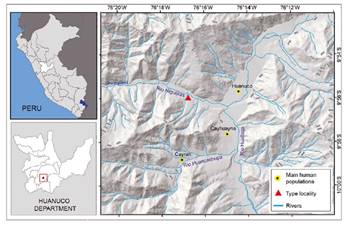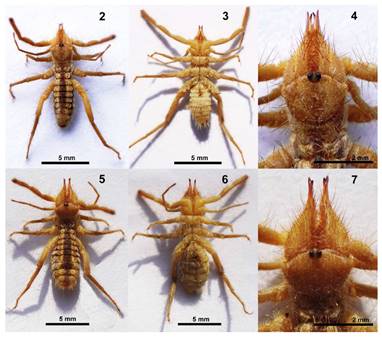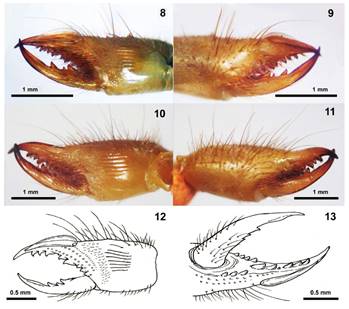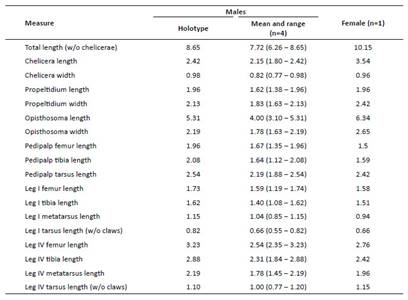Introduction
As a result of recent taxonomic reseach, the solifuge family Mummuciidae Roewer, 1934 has undergone several changes in the last decade. In addition to the creation of two new genera (Botero-Trujillo et al. 2016, 2019), the genera Gauchella Melo-Leitao, 1937 and Metacleobis Roewer, 1934 have been removed as valid taxa of this family (Botero-Trujillo et al. 2017). Mummuciidae currently has eight valid genera: Mummucia Simon, 1879; Gaucha Melo-Leitao, 1924; Mummucina Roewer, 1934; Mummucipes Roewer, 1934; Cordobulgida MelloLeitao, 1938; Uspallata Mello-Leitao, 1938; Vempironiella Botero-Trujillo, 2016 and Curunahuel Botero-Trujillo, 2019.
The genus Mummucina is only known from the west of South America and is characterized by the absence of dorso-apical spiniform setae on tibiae of legs II and III, the presence of nine (1. 2. 2. 4) latero-ventral spiniform setae on tarsi of legs II and III, 12 (2.2.2-2.4) latero-ventral spiniform setae on tarsi of leg IV, and three anterior teeth on the cheliceral fixed finger (Roewer 1934; Muma 1971).
Six species were described for this genus: M. exlineae Mello-Leitao, 1943 and M. masculina Lawrence, 1954 from Peru; M. colinalis Kraus, 1966 and M. romero Kraus, 1966 from Chile; M. titschackiRoewer, 1934 from Ecuador, and M. punaGonzález & Corronca, 2013 from Argentina. Mummucina romero, however, was recently transferred to the genus Chileotrecha, within the Ammotrechidae family (Botero-Trujillo & Iuri 2015), which brings the number of known species of the genus to five. On the other hand, M. exlineae is considered Insertae Sedis (González and Corronca 2013) for its description not corresponding to the diagnosis established for the genus by Roewer (1934), lacking an illustration of the species and because it is considered that the only individual on which description is based has been lost or destroyed (Kury and Nogueira 1999).
This publication describes a new species of Mummucina for Huanuco, Peru, including the description of the male and female.
Material and methods
The specimens used in this paper were collected during a field expedition focussed on multiple taxa. They were found 20 meters from the Higueras River, in the locality of Kotosh, province and department of Huanuco, Peru, with coordinates 9°55.8’S and 76°16.7’W, at 1946 m of altitude (Fig. 1). Specimens have been stored in vials with 70% ethanol and deposited in the Museo de Historia Natural Javier Prado of the Universidad Nacional de San Marcos (Lima, Peru; MUSM).

Figure 1 Distribution of Mummucina chaskae sp. n. Higueras River, in the locality of Kotosh, province and department of Huanuco, Peru.
The terminology used to describe the species followed Bird el at. (2015) for cheliceral teeth and other cheliceral structures, and Bird and Wharton (2015) and BoteroTrujillo (2016) for leg and pedipalp segmentation. Description of the pattern of spiniform setae on legs follows the formula proposed Iuri et al. (2014), using a dash (-) to represent incomplete segmentation and a slash (/) for complete segmentation. Following Botero-Trujillo (2014), the so-called "spines" of the legs are here called "spiniform setae", since they are articulated. To describe the chelicerae, the right chelicera was separated from each individual observed, including the holotype. Colour was determined according to the Munsell colour chart. Photographs were taken with a Sony alpha 6400 camera, adapted to a stereomicroscope. Illustrations were made using a camera lucida. Measurements are expressed in millimetres.
Mummuciidae Roewer, 1934
Genus MummucinaRoewer, 1934
Type species: M. titschackiRoewer, 1934, by original designation
Mummucina chaskae sp. nov.

Figures 2 7. Mummucina chaskae sp. n. (2 - 4) Male holotype (MUSM-ENT-00514001), (2) dorsal view; (3) ventral view, (4) propeltidium and chelicerae view. (5 - 7) Female paratype (MUSM-ENT-00514002), (5) dorsal view, (6) ventral view, (7) propeltidium and chelicerae view.
Type material.Male holotype (MUSMENT-00514001), 1 female and 3 males paratypes (MUSMENT-00514002), PERU, Huanuco department, Huanuco province (near to Kotosh archaeological site, 1946 m; 9°55.8’S, 76°16.7’W), April 14, 2019, E. Daniel Cossios.
Diagnosis.Mummucina chaskae differs from the other species of the genus, for both males and females, by the following combination of traits: ground colour yellowish, propeltidium with a diamond-shaped central mark slightly darker than the rest, poorly distinguishable; dental pattern of the cheliceral fixed finger: FD-(1)FM-(2)-FP-(4RF)(3PF), the distal FSM very small in size. M. titschacki, the species morphologically most similar to M. chaskae, bears a similarly shaped flagellum and a variable number of cheliceral teeth that makes some individuals match the dental pattern recorded for M. chaskae, but has a different colour, with greyish white ground colour and the central area of the propeltidium noticeably darker than the rest.
Description of the male holotype.Color: (Figs. 2-4, 8-9) Propeltidium and peltidium yellowish (10YR 7/6). Propeltidium with posterior border and a central diamond spot yellowish red (5YR 4/6), not well distinguishable from the rest of the propeltidium. Parapeltidium creamy white (2.5Y 8/1). Eyes black. Chelicerae yellowish with reddish (2.5YR 4/8) internal borders and a yellow (2.5Y 8/8), thin longitudinal dorsal band in the medial zone. Mesopeltidium, metapeltidium and abdominal tergites crossed by a median dark reddish brown (5YR 3/4) band and lateral bands creamy white. Pleural membranes with a thin creamy white longitudinal stripe contiguous to the abdominal tergites, followed by a very dark brown stripe (5YR 2.5/2) and borders creamy white. In some individuals, the median dark stripe is absent in the last two tergites. Pedipalps yellowish, gradually darkening from the tibia to the end of telotarsus. Legs yellowish, with darker tarsi. Ventrally, sternites creamy white. Malleoli yellowish with reddish border, except the distal ones (those on throcanter-2) which have a very dark brown border.
Prosoma: (Figs. 2-4). Propeltidium 1.15 wider than long (Fig. 4), with anterior margin convex and scattered long, medium-sized, and short setae; a row of mediumsized setae parallel to the anterior margin of the propeltidium. Ocular tubercle elevated; distance between eyes about one time the eye diameter. Lateral lobes separated from the propeltidium by a lateral groove. Peltidium narrow, with bifurcated setae of variable size. Parapeltidium smooth. Meso and metapeltidium trapezoidal, with scattered seta. Coxae covered with bifurcated setae.
Chelicera: (Figs. 8-9, 12-13) Prolateral surface with stridulatory apparatus with seven ridges. Movable finger with three teeth situated in medial position on the finger: two primary teeth (MM and MP) and an MSM secondary tooth, and arranged in increasing size: MSM, MM, MP. Small diastema between MM and MSM. Fixed finger with dental pattern FD-(1)-FM-(2)-FP-(4RF)(3PF), with teeth of the median series arranged in increasing size: distal FSM, FSD, proximal FSM, FD, FM, FP; the distal FSM very reduced in size. Retrofondal and profondal teeth decreasing in size proximally. Retrolateral and dorsal surfaces with setae variable in size. Prolateral surface with two rows of plumose setae (pvd) covering the fixed finger teeth and disposed along the border of the fixed finger teeth line, the first one going from the FM tooth to the ventral extreme of the fixed finger base, the second row parallel to the first one but shorter, from the FM tooth to the middle of the chelicera. A row of thick and short setae (pvsd comb) in front of the stridulatory apparatus. Area between the stridulatory apparatus and the pvsd comb covered by short bristles (pm). Prolateral face of the movable finger with several strong setae on its basal half. Dorsal keel on the fixed finger, starting over the end of the FM tooth (close to the base of the flagellum) and ending close to the finger tip.

Figures 8 13. Chelicerae of Mummucina chaskae sp. n. 8-9: Right chelicera of male holotype, prolateral and retrolateral aspects. 10-11: Right chelicera of female paratype, prolateral and retrolateral aspects. 12: Diagram of the right chelicera of a male paratype, prolateral aspect, plumose setae omitted. 13: Diagram of the right chelicera of a male paratype, in an inclined prolateral aspect.
Flagellum: (Figs. 8, 12) Translucent and immobile drop-shaped membrane, laterally compressed, with an elongated apex. Dorsal border convex, ventral border slightly concave, running parallel to the ventral edge of the fixed finger. Apex almost reaching the finger tip.
Pedipalps: Typical of Mummuciidae solifuges. Without spines but densely covered with setae of different types and length, including blunt, bifurcated and clubbed setae. Telotarsus with a dorsodistal pore area.
Leg I: Thin, without claws or spiniform setae. Like pedipalp in the types of setae and their density.
Walking legs: Covered with several bifurcated and blunt setae of variable size. Legs II and III: tibia with a distal pair of ventrolateral spiniform setae, one ventral spiniform seta at the medial zone and a dorsal one at the distal third of the tibia; basitarsus with 1.1.2.2 ventrolateral spiniform setae; telotarsus bi-segmented, and 1.2.2/4 ventrolateral spiniform setae. Leg IV: tibia with a distal pair of ventrolateral spiniform setae; basitarsus with 1.1 ventral spiniform setae on prolateral aspect; telotarsus bi-segmented with pseudosegmentation on the basal segment, and 2.2.2-2/4 ventral spiniform setae. In all the walking legs, the four distal spiniform setae with the outer pair longer than the inner.
Opistosoma: (Figs. 2-3) Tergites setose, with bifurcated setae of medium size, and some longer. Sternites densely covered with bifurcated setae. Abundant ctenidia, disposed in rows, on the posterior half of the postspiracular sternites I and II.
Female paratype.(Figs. 5-7, 10-11) Same color as the male. Other morphological characters also same as the male, except the following: a) Propeltidium 1.4 times wider than long (Fig. 7), b) edges of the malleoli lighter colored than in males, c) chelicerae typical of Mummucina females, without flagellum (Figs. 10-11).
Variability.Measurement variability is shown in Table 1. One of the four examined males presented a different spiniform setae pattern on the tarsus of the right leg II (1.1.2.4 instead of 1.2.2.4) and two others presented a different pattern on the tarsus of the right leg III, one of them missing two spiniform setae (1.2.4 instead of 1.2.2.4) and another with a supernumerary seta (1.2.2.5 instead of 1.2.2.4). This type of variation is probably the result of setae that have fallen or broken, teratologies or regenerated legs.
Etymology.The specific name is a patronym for the author´s daugther, Chaska Cossios Veillon.
Natural habitat and distribution.Species known only from the type locality. Recorded habitat corresponds to a transition between riverine forest and xeric scrubland. In the first plant community, trees that stand out are Salix humboldtiana and Tessalia integriflora. In the xeric scrubland, the trees Schinus molle and Vachellia macracantha, the shrub Jathropha augusti, the columnar cactus Espostoa lanata and the succulent Agave americana stand out. The climate of the area is typical of the central highlands of Peru, rainy between October and April and dry between May and September, with an annual cumulative rainfall of 370 mm, an average minimum temperature of 12.4 °C in July, and an average maximum temperature of 26.4 °C between October and December.
Comments.Roewer (1934) used the spiniform setae pattern of the leg I-IV tarsi as one of the defining characteristics of the genus Mummucina. Mummucina chaskae showed variability in this pattern, with the absence of some of the expected spiniform setae in two male specimens (out of a total of 4 studied specimens) and a supernumerary seta in the case of another specimen. Rocha & Cancello (2002) and Maury (1982) also observed variability in the pattern of the tarsal spiniform setae in other Mummuciidae species. Based on these observations, they suggested that the pattern of spiniform setae is not a critical characteristic to define species or genus. However, other authors point out that the patterns are quite uniform and that the found deviations should correspond to broken setae or to individual morphological anomalies (e.g. Botero-Trujillo et al. 2017).
Mummucina chaskae is the third species of the genus described for Peru, and the first for the department of Huanuco. Since this genus is found from central Ecuador to central Chile, passing through northwestern Argentina, it is expected to also be found in much of the highlands of western Peru, possibly with species not yet registered.












 uBio
uBio 



